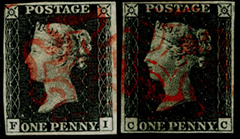 First Issues Collectors Club
of stamps and philatelic material
First Issues Collectors Club
of stamps and philatelic material
Home - Catalog - Categories - Index - Journal - Exhibits - Auctions - Forgeries - Join
 First Issues Collectors Club
of stamps and philatelic material
First Issues Collectors Club
of stamps and philatelic material
Home - Catalog - Categories - Index - Journal - Exhibits - Auctions - Forgeries - Join
| first issues > countries > norway |
| Europe | 11 |
Imperforate, watermark 159 (Lion), typographed.
Printed by Christian Wulfsberg in Christiania (now Oslo).
| Description | # printed | # issued | Scott # | SG | Mi | Y&T |
|---|---|---|---|---|---|---|
4 skilling blue |
over 2,200,000 | 2,018,200 | 1 | 1 |
The paper used was produced from material that was cheaply and readily available: hemp from ships ropes and canvas from sails. It was handmade and of a poor quality. The thickness varies, the texture is uneven and it could contain lumps that made printing difficult.
The watermark was produced by pressing a die into the metal cloth on which the paper is produced. The paper is therefore thicker where the watermark is located, opposite most other watermarks. Some early Russian stamps have the same kind of watermark.
The printing was done using typography. A steel die was transferred to a copper plate from which clichés were cast in type metal. The clichés often oxidated and the oxide eventually fell off. Many of the stamps are therefore found with white spots where the cliché had worn off like this. One printing plate or sheet consisted of four panes of 50 stamps each.
The spacing between the stamps was quite large, 3mm horizontally and about 3½mm vertically. A fine quality stamp should therefore normally have margins that on most other stamps would be considered very large or even huge. The individual panes were spaced about 20mm horizontally and 27mm vertically. The sheet margin is 10 - 15mm at the top and bottom and 8 - 10mm on either side.
The postmarks found were originally gridiron killers. They were used from January 1, 1855 to January 26, 1856, or just over one year. The most common types have 11 or 12 bars. Cancels with 10 bars are less common and are known on covers from the towns of Frederikstad, Hønefos and Kragerø. A letter was supposed to be postmarked with a handstamp in blue ink and the stamp cancelled in black. Now and then the grid cancel was done in blue ink. The gridiron cancels were recalled after January 26, 1856 and circular datestamps were used until June 26, 1856 when the three ring numeral cancels were put in use. The numbers assigned to the towns were between 1 and 383. Not all numbers are known on stamps or covers today. About 20 numeral cancels are known in blue ink. Only number 123 is known in red ink.
Pen cancellations are not very common. Only about 5 percent of the known stamps are pen cancelled, compared to 50% grids, 30% numerals and 15% circular town datestamps.
| Year | Color | Description | # issued |
|---|---|---|---|
| 1914 | Medium blue | Anderssen & Dethlof: Norges frimerker 1855-1914 | 550 |
| 1924 | Dark blue | Anderssen & Dethlof: Norges frimerker 1855-1924 | 1000 |
| 1955 | Blue | NORWEX souvenir sheet. Reproduction on white art paper | 5585 |
| 1955 | Blue | NORWEX souvenir sheet. Reproduction on red carton paper | 37,050 |
| 1962 | Light blue | Handbok over Norges frimerker 1855-1955 | 4000 |
Most forgeries are crude and easily detected because of errors in the design. A genuine stamp has 39 horizontal lines in the circle and 24 vertical in the shield. The forgeries also lack a watermark. Falsified cancellations are also found but a few are easily detected. For example, the highest number used in genuine three ring cancels is 383, from the town of Nittedal. When you encounter a stamp with number cancel 424, 480 or 541 you therefore know it is a forged cancellation. Beware of stamps with removed or altered pen cancels.
Images from David Olson.
| FI ref: 52 | Page credit: JA |
| Page created 19 Feb 2014 | Page updated 26 Jun 2016 |